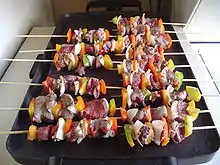List of kebabs
This is a list of kebab dishes from around the world. Kebabs are various cooked meat dishes, with their origins in Middle Eastern cuisine and the Muslim world. Although kebabs are often cooked on a skewer, many types of kebab are not.[1][2][3]
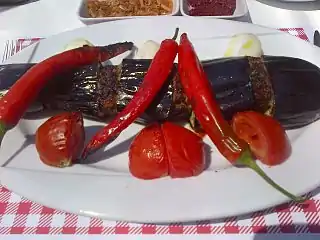
Afghanistan
Africa
| Name | Image | Description |
|---|---|---|
| Sosatie | 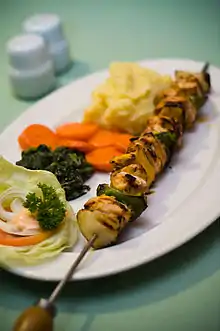 |
A dish of the Cape Malay people of South Africa.[4] It is a type of kebab related to satay, which came to Indonesia via Muslim traders from India, and was brought from there to South Africa.[5] |
| Suya | 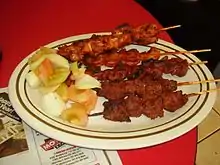 |
A popular spicy meat kebab enjoyed by many across West Africa. A recipe of the Muslim Hausa people in northern Nigeria and southern Niger, this kebab has tastes of peanuts and spicy pepper and is sold by street vendors as a snack or entire meal. The kebabs are enjoyed with onion and bell pepper pieces. It is a traditionally Muslim kebab, prepared according to Halal methods.[6] |
| Kyinkyinga | The northern Ghanaian kebab, synonymous with suya in Nigeria, and prepared by the same Hausa ethnic group[7][8][9] |
Azerbaijan
| Name | Image | Description |
|---|---|---|
| Lyulya kebab | 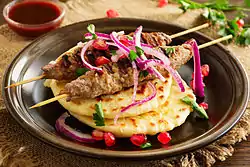 |
(Russian: люля-кебаб) – served skewered or wrapped in lavash bread[10] |
| Sham kebab | ||
| Tava kebab |
Bangladesh
| Name | Image | Description |
|---|---|---|
| Bihari kabab | 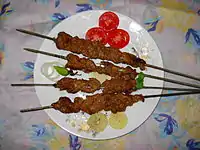 |
Skewered pieces hunks or strips of lean beef, marinated in spices, yogurts and chillies and tenderised to perfection before slowly grilled on a charcoal flame. The dish was brought from Bihar, India. (see Biharis in Bangladesh).[11] |
| Boti kebab |  |
This is a mutton kebab, similar to the English sausage.[12] |
| Naga doner kebab | One of the most well-known British Bangladeshi kebabs, commonly eaten in East London, England. It is made of meat cooked on a vertical rotisserie, and then drizzled with the Naga morich. It is also known to be the most spiciest kebab due to the presence of the chilli. It can be fused with the Shatkora kebab as well (see below). | |
| Jali kebab | A reticular, tender kebab possibly originating from Old Dhaka. The name comes from jali, meaning net. | |
| Kathi kebab | 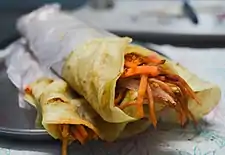 |
Beef, chicken or mutton kebab wrapped in a layered porota, marinated in spices. The meat is tossed with onions, chillies and sauces before being laid in a thin strip on the centre of the porota. Various kinds of sauces, a dash of vinegar, a squeeze of lime are also added. It is also known as Porota Kebab. |
| Reshmi kebab | Minced chicken adequately seasoned and then barbecued on a charcoal grill.[13] | |
| Seekh kebab |  |
Prepared with minced meat with spices and grilled on skewers.[14] It is often served with a Bengali sauce known as Raita or mint sauce. |
| Shami kebab | 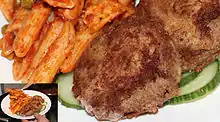 |
Normally made of minced meat, with paste of lentils and chopped onion and coriander and green chillies usually added to the mixture, which is kneaded in a disc-like shape and fried. Best results are obtained when fried in ghee. In some places, a binding agent is used to keep the kebab together. Meat can also be replaced with egg, known as Dim Kebab or Enda Kebab. |
| Shatkora doner kebab | One of the most well-known British Bangladeshi kebabs, commonly eaten in East London, England as well as other areas with a high Bangladeshi diaspora. It is made of meat cooked on a vertical rotisserie, and then drizzled with the Shatkora fruit. It can be fused with the Naga doner kebab as well (see above). It may be equivalent to the Sylheti kebab eaten in Kolkata.[15] | |
| Shutli kebab |  |
Shutli or shuta kabab is made by wrapping mixed pastes of spices and meat around a metal sheekh, tying it with a cotton thread (shuta) & then heating on a barbecue pit. Once the kabab is done, the thread is removed & the kebab is served.[16] The name comes from the Bengali word shuta meaning thread.[17] |
| Tikka kebab | .jpg.webp) |
Made of chunks of grilled chicken marinated with yogurts, sauces and spices.[18] |
China
| Name | Image | Description |
|---|---|---|
| Chuanr | 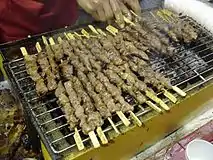 |
Uyghur: Kewap, Chinese: 串儿 Chuanr or 羊肉串 Yangrouchuan — The most popular Xinjiang dish in China: chunks of mutton or mutton fat pierced on metal (or wood or bamboo) skewers, grilled on a coal-fired barbecue, and served with cumin and chili paste. Across Xinjiang, and neighbouring regions such as Kyrgyzstan, the mutton fat is valued equivalent to or more than the meat itself, as it provides energy during the harsh winter months. It has also become a popular street food all over north and west China, where a wide variety of foods are cooked in such a manner. Chuanr was traditionally made from lamb (yáng ròu chuàn, 羊肉串), which is still the most common, but now, chicken, pork, beef, and seafood are used. It is typically roasted over charcoal or electric heat, but it is sometimes cooked by deep frying in oil (popular in Beijing). |
Cyprus
| Name | Image | Description |
|---|---|---|
| Sheftalia |  |
A traditional Cypriot sausage made of ground pork or lamb and wrapped in caul fat that is served alone or in a pita, usually with tomato, cucumber, parsley, and lemon |
| Souvlaki | 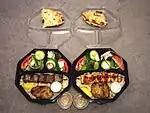 |
Skewers consisting of pork, chicken or lamb that is barbecued.[5][19] Pictured is a souvlaki platter. |
Greece
| Name | Image | Description |
|---|---|---|
| Gyros | 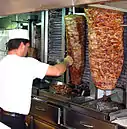 |
Introduced to Athens in the 1950s by immigrants from Turkey and the Middle East, gyros was originally known simply as döner kebab.[20] Made from chopped meat, usually pork or chicken, formed into a large loaf for slow-roasting on a vertical rotisserie cooker, the auto-donner. (See also doner kebab.) Thin portions are shaved off and served in a pitta bread with onion and Greek yogurt-cucumber-garlic sauce, tzatziki. Popularized in US by Greek restaurateurs in the Greektown, Chicago neighborhood. |
| Souvlaki | In the 1960s, vendors began selling dishes in the same style as gyros, made with souvlaki, which resembles Turkish shish kebab, but is usually made with pork.[20][5] Souvlaki (skewer) consists of small skewers of meat, barbecued, then served plain, in a pitta sandwich, or with salad. Chicken[21] and lamb are also sometimes used. It is sometimes served on a skewer, or as a dinner in combination with rice, potatoes, and tzatziki sauce. In Athens, it is called kalamaki, with souvlaki referring to both gyros and kalamaki. |
India
| Name | Image | Description | |
|---|---|---|---|
| Bihari kabab |  |
Skewered pieces of meat marinated in spice. Originally a dish from the non-vegetarian cuisine, Muslims invented Bihari kabab of the North Indian state of Bihar as it is made out of beef . It has spread to other countries.[11] | |
| Boti kebab |  |
A mutton kebab.[22] Boti kebab is pictured at the bottom of the image | |
| Achari Tikka | |||
| Chicken tikka | .jpg.webp) |
Another tandoori kebab, made of cubed chicken marinated with yogurt and spices[18] | |
| Dora kabab[23][24] | |||
| Galawat kabab | A variant of Shami kebab made without any admixture or binding agents and comprising just the minced beef (Muslim origin) and the spices. Speciality of Lucknow. | ||
| Hariyali kabab | Punjabi style chicken tikka or kabab made with combination of mint and coriander | ||
| Kakori kabab | Made of minced beef meat with spices, a specialty of Muslims of Lucknow & Delhi | ||
| Galauti kebab | A smoked patty prepared using leg of lamb that includes onion, garlic, ginger, saffron and spices, which is cooked on a griddle[25] | ||
| Hariyali kebab | A vegetarian kebab prepared using lentils and spinach[26][27] | ||
| Tangri kebab | Chicken legs roasted on open fire with hot spices and laced with butter or ghee[28] | ||
| Kastoori kebab[29] | |||
| Dahi ke kabab[30] | |||
| Burra kebab[31][32] | |||
| Kalmi kebab | 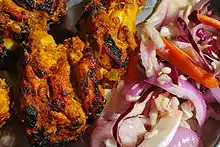 |
A chicken kebab.[33] Kalmi kebab is pictured on the left in the image. | |
| Paneer kabab | Vegetarian kebab | ||
| Reshmi kabab | A traditional kebab of Mughlai cuisine that is prepared with marinated chicken, lamb or beef[34] | ||
| Shami kebab |  |
Made of minced beef, with paste of lentils and chopped onion and coriander and green chillies usually added to the mixture, which is kneaded in a disc-like shape and fried. Best results are obtained when fried in animal fat or ghee in a brass utensil over a coal fire. In some places, a binding agent is used to keep the kebab together. | |
| Shikampur kabab | |||
| Sutli Kebab |  |
Sutli kabab is made by wrapping a paste of meat & spices around a metal sheekh, tying it with a cotton thread & then heating it in a barbeque pit. Once the kabab is done, the thread is removed & the kabab is served.[16] |
Iran
Not every dish containing the word "kebab" is listed below. For example, chelow kabab (چلوکباب, lit. 'cooked rice plus kebab') is not listed, because it is a meal consisting of cooked rice and one of the many kebab types listed below. Such is the case of kabāb turki (کباب ترکی, Persian variation of shawarma), Tāskabāb (تاسکباب, actually a stew), kabāb shāmi (کباب شامی, cutlets). or Tābeh kabāb (تابه کباب, pan-fried ground beef).
| Name | Image | Description |
|---|---|---|
| Joujeh kabab (جوجه کباب, lit. 'roasted chicken') | 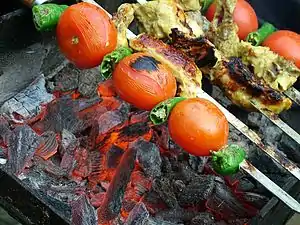 |
Grilled chicken on skewers |
| Kabab bakhtiari (کباب بختیاری, lit. 'Bakhtiari kebab') | Combination of jujeh kabab and kabab barg | |
| Kabab barg (کبابِ برگ, lit. 'grilled pieces') | 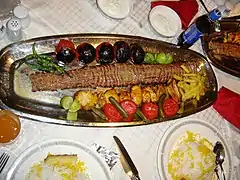 |
Grilled marinated sirloin. |
| Kabab barreh (کباب برّه, lit. 'grilled lamb') | Grilled lamb, typically marinated in yogurt with parsley | |
| Kabab chenjeh (کباب چنجه) | Grilled lamb prepared similar to shish kebab, without the vegetables | |
| Kabab digi (کباب دیگی, lit. 'pot-cooked kebab') | ||
| Kabab hosseini (کباب حسینی) | Lamb or beef cooked on skewers with onions, tomatoes and green peppers | |
| Kabab koobideh (کبابِ کوبیده, lit. 'flattened kebab') | 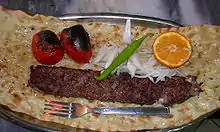 |
Ground beef or lamb (usually sirloin), often mixed with parsley and chopped onions. The mixture is formed into a flat stripped and grilled on extra-wide skewers. |
| Kabab kordi (کبابِ کُردی, lit. 'Kurdish kebab') | Ground lamb or beef, onions, garlic, and tomatoes | |
| Kabab loghmeh (کباب لقمه, lit. 'bite-sized kebab') | Minced lamb meatballs first fried and the grilled over charcoal fire, eaten with chopped parsley, chopped onions, and sumac. A summer outing favorite. | |
| Kabab rashti (کباب رشتی, lit. 'kebab of Rasht') | Includes almond, pistachio, and barberry | |
| Kabab shamshiri (کباب شمشیری, lit. 'Sword-like kebab') | Consists of kabab barg on one end of skewer and kabab koobideh on the other | |
| Kabab soltani (کباب سلطانی, lit. 'royal kebab') | A meal that consists of a combination of jujeh kabab and kabab barg, prepared in different skewers but served together | |
| Kabab torsh (کبابِ ترش, lit. 'sour kebab') | Grilled beef marinated in a mixture of pomegranate juice, crushed walnuts, parsley, crushed garlic, and olive oil | |
| Kabab vaziri (کبابِ وزیری, lit. 'nobility kebab') | A meal that consists of a combination of jujeh kabab and kabab koobideh, prepared in different skewers but served together | |
| Kabab-e donbalan | Lamb testicles kabab[35] | |
| Gojeh kabab (گوجه کباب, lit. 'grilled tomato') | Tomatoes grilled in varying degrees, depending on the taste of the eater. Almost never eaten alone, but are served alongside other kebab. | |
| Donbeh kababi (دنبه کبابی, lit. 'grilled tail fat') | Very small amount of lamb tail fat, grilled alongside other kebabs to enhance their taste and richness. Never consumed alone. | |
| Jigar (جیگر) | Grilled lamb liver, placed between slices of bread to preserve its juice. Some delicacy variations of the dish include grilled heart or kidney in the same manner. Because of potential health issues, it is often consumed with vegetables, fresh lemon's juice, onion, pepper, or other spice. The name is a variation of جگر (lit. 'Liver'). | |
| Kebab golpayegan[36] |
Levant
| Name | Image | Description |
|---|---|---|
| Kabab Memuleh b'hatzilim | A kebab balls made of minced beef, garlic, parsley, baharat, salt, black pepper, onions and cumin which stuffed with a mixture of fried or grilled eggplants and tahini. Originally from Israel. | |
| Kebab halabi | A kind of kebab served with a spicy tomato sauce and Aleppo pepper, very common in Syria, Lebanon and the Galilee region in Northern Israel, named after the city of Aleppo (Halab). Aleppo is well known for its kebab cuisine, reportedly having at least 26 original dishes.[37] | |
| Kebab hindi | Rolled meat with tomato paste, onion, capsicum and pomegranate molasses | |
| Kebab kamayeh | Soft meat with truffle pieces, onion and various nuts | |
| Kebab karaz | For cherry kebab in Arabic – meatballs (lamb) along with cherries and cherry paste, pine nuts, sugar and pomegranate molasses. It is considered one of Aleppo's main dishes, especially among Armenians. | |
| Kebab khashkhash | 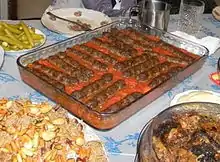 |
Rolled lamb or beef with chili pepper paste, parsley, garlic and pine nuts. Pictured is Kebab khashkhash from Aleppo. |
| Kebab siniyye | For tray kebab in Arabic – lean minced lamb in a tray added with chili pepper, onion and tomato | |
| Kebab tuhal | Lamb rounds stuffed with parsley, hot green peppers and pine kernels[38] | |
| Shawarma | 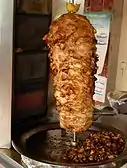 |
Similar to a doner kebab, traditionally made with chunks of lamb meat, but also with chicken, turkey, beef or veal |
Pakistan
| Name | Image | Description |
|---|---|---|
| Chapli kebab | 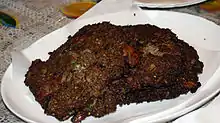 |
A delicacy of Pakistan from Khyber Pakhtunkhwa province – marinated beef in spices and deep fried flat.[39] In Pakistan, it is sometimes deep fried in animal tallow, and it is a common kebab.[lower-alpha 1] |
| Lola kabab/Gola kabab | Kabab of Pakistan and Afghanistan – rolled meatballs originating in Peshawar and Kandahar. | |
| Seekh kebab |  |
Prepared with minced meat with spices and grilled on skewers. It is cooked in a Tandoor, and is often served with chutneys or mint sauce. A seekh kebab can also be served in a naan bread much like döner kebab. |
| Shami kebab |  |
Made of minced meat, with paste of lentils and chopped onion and coriander and green chillies usually added to the mixture, which is kneaded in a disc-like shape and fried. Best results are obtained when fried in ghee. In some places, a binding agent is used to keep the kabab together. |
| Malai tikka | Chunks or strips of chicken marinated in a white yoghurt and garlic sauce and grilled. | |
| Reshmi kebab | Minced chicken adequately seasoned and then barbecued on a charcoal grill. | |
| Khaddi Kebab | Authentic baluchistan cuisine..a whole lamb is stuffed with flavored rice, marinated and inserted in a dug hole with wood around to cook it..the hole is filled up and whole lamb is cooked underground for some time. | |
| sheesh tauk kebab | pieces of chicken on stick marinated and lightly grilled. | |
| lamb sajji kebab | The lamb is cooked on its own fat and no oil is used. The key ingredients of this appetizing food include lamb meat, rice, vinegar, red chili powder, black pepper, salt, garlic paste, lemon juice, ajwain, fennel seeds, cumin seeds, coriander seeds, lemon juice and oil. | |
| shahi gola kebab | aunthetic lahore cuisine | |
| shashlik kebab | square skewers of beef
lamb or chicken partitioned with tomatoes capsicum and onion | |
| Bihari kebab | Chunks or strips of lean beef, marinated in a spicy yoghurt/chilli marinade and tenderized to perfection before slowly grilled on a charcoal flame. | |
| chandan kebab | mixed meat kebabs | |
| gilafi kebab | ||
| kaleji tava kebab | liver kebabs. | |
| tawa chicken boti kebab | ||
| dawat e ishq kebab | ||
| sindhi handi kebab | ||
| chicken tikka resa kebab | ||
| chicken angara kebab | big chicken chunks marinated with a special spice combination and grilled over charcoal | |
| mahi seeks kebab | fish seekh kebabs | |
| chicken tandoori kebab |
Romania
| Name | Image | Description |
|---|---|---|
| Frigărui | 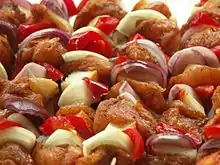 |
Small pieces of meat (usually pork, beef, mutton, lamb or chicken) grilled on a skewer, very similar to shashlik,[42] or shish kebab. Often, the pieces of meat alternate with bacon, sausages, or vegetables, such as onions, tomatoes, bell peppers and mushrooms. It is seasoned with spices such as pepper, garlic, savory, rosemary, marjoram and laurel. |
Spain
| Name | Image | Description |
|---|---|---|
| Pincho moruno | 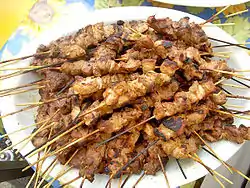 |
Meat skewer, usually made of chicken or pork, sliced in cubes, marinated in paprika and other spices. |
Turkey
| Name | Image | Description |
|---|---|---|
| Adana kebabı | 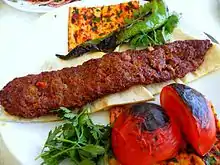 |
Also known as kıyma kebabı – kebab with hand-minced (zırh) meat mixed with chili on a flat wide metal skewer (shish); associated with Adana region although very popular all over Turkey.[43] |
| Ali Paşa kebabı (Ali Pasha kebab) | Cubed lamb with tomato, onion and parsley wrapped in filo[43][44] | |
| Alinazik kebab |  |
Ground meat kebab sautéed in a saucepan, with garlic, yogurt and eggplants added |
| Antep kebabı |  |
Half-fat minced meat mixed with thin slices of the same meat and made into balls and cooked between thick slices of eggplant |
| Bahçıvan kebabı[45] |  |
Boneless lamb shoulder mixed with chopped onions and tomato paste |
| Beykoz kebabı |  |
Tomato and onion flavoured lamb, wrapped in aubergine slices and garnished with lamb brains[43] |
| Beyti kebab |  |
Ground lamb or beef, seasoned and grilled on a skewer, often served wrapped in lavash and topped with tomato sauce and yogurt, traced back to the famous kebab house Beyti in Istanbul and particularly popular in Turkey's larger cities.[46] |
| Bostan kebabı | Lamb and aubergine casserole.[43] | |
| Cağ kebabı (spoke kebab) | 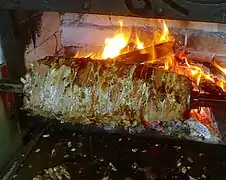 |
Cubes of lamb roasted first on a cağ (a horizontal rotating spit) and then on a skewer, a specialty of Erzurum region with recently rising popularity |
| Çardak kebabı[47] | Stuffed lamb meat wrapped in a crepe or filo. | |
| Ciğer kebabı (liver kebab) | 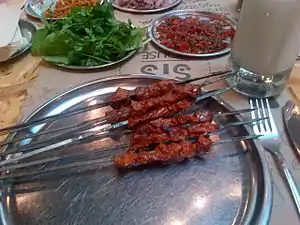 |
Lamb liver kebab on a skewer (a.k.a. ciğer şiş) |
| Çökertme kebabı |  |
Sirloin veal kebap stuffed with yogurt and potatoes |
| Çöp şiş (small skewer kebab) |  |
A specialty of Selçuk and Germencik near Ephesus, pounded boneless meat with tomatoes and garlic marinated with black pepper, thyme and oil on wooden skewers[48] |
| Doner kebab | .jpg.webp) | |
| İskender kebap |  |
Döner kebap served with yogurt, tomato sauce and butter, originated in Bursa. The kebab was invented by İskender Efendi in 1867. He was inspired from Cağ kebab and turned it from horizontal to vertical. |
| İslim kebabı (stew) | 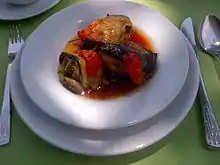 |
Another version of the aubergine kebab without its skin, marinated in sunflower oil[43][48] |
| Kağıt kebabı | 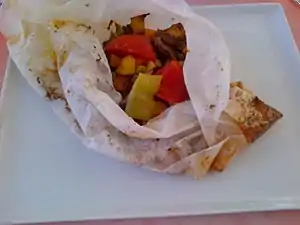 |
Lamb (or veal) cooked in a paper wrapping[48] |
| Kılıç şiş | Brochette of swordfish[43] | |
| Şiş köfte | 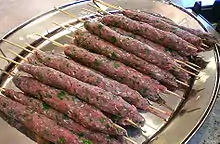 |
Also known as Shish köfte – minced lamb meatballs with herbs, often including parsley and mint, on a stick, grilled |
| Kuyu kebabı (pit kebab) | Prepared from the goat it is special for Aydın region, similar to tandır kebabı | |
| Kuzu şiş | 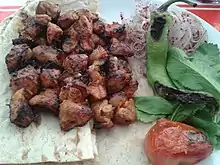 |
Shish kebap prepared with marinated milk-fed lamb meat |
| Manisa kebabı | This Manisa region version of the kebab is smaller and flat size shish meat on the sliced pide bread, flavored with butter, and stuffed with tomato, garlic and green pepper. | |
| Orman kebabı (forest kebab) | Lamb meat on the bone and cut in large pieces mixed with carrots, potatoes and peas[43] | |
| Patates kebabı[49] | Beef or chicken mixed with potatoes, onions, tomato sauce and bay leaves | |
| Patlıcan kebabı (aubergine kebab) |  |
A unique kebap meat marinated in spices and served with aubergines, hot pide bread and a yogurt sauce[48] |
| Şiş kebabı | 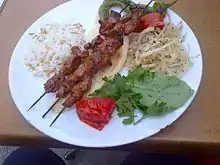 |
Prepared with fish, lamb or chicken meat on thin metal or reed rods, grilled[43][48] |
| Şiş tavuk | 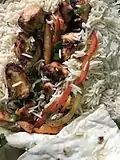 |
Also known as Tavuk şiş or – Yogurt-marinated chicken grilled on a stick[48] |
| Sivas kebabı | Associated with the Sivas region, similar to Tokat kebab but especially lamb ribs are preferred and it also differs from Tokat kebabı on the point that there are no potatoes inside | |
| Tandır kebabı (tandoor kebab) | Lamb pieces (sometimes a whole lamb) baked in an oven called a tandır, which requires a special way of cooking for hours. Served with bread and raw onions.[43] | |
| Tantuni | 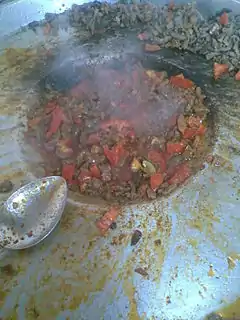 |
Tantuni is a spicy dürüm consisting of julienne cut beef or sometimes lamb stir-fried on a sac with a hint of cotton oil. It is a specialty of the city of Mersin, Turkey. |
| Tas kebap (veal stew) |  |
Stewed meat in a bowl, beginning with the cooking of the vegetables in butter employing a method called yağa vurmak, ("butter infusion"), before the meat itself is cooked in the same grease |
| Testi kebabı (earthenware-jug kebab) | Ingredients are similar to çömlek kebabı, prepared in a testi instead of a güveç, generally found in Central Anatolia and the Mid-Western Black Sea region | |
| Tire kebabı | Minced meat cooked on sheesh and served with maydanoz and sauce, on top of special tire bread | |
| Tokat kebabı | Associated with the Tokat region, it is made with marinated lamb, grilled inside an oven, together with aubergines, tomatoes, potatoes, entire onions and garlics and served over a special flatbread called lavaş (a thicker yufka) and softened with the juice of the meat and tomatoes. | |
| Urfa kebabı | From Urfa, similar to Adana kebab, but not spicy | |
| Vali Kebabı
(Governor Kebab) |
 |
Others
| Name | Image | Description |
|---|---|---|
| Chislic | 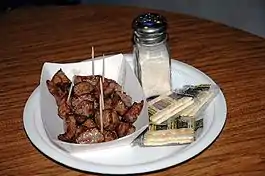 |
This is a migration of Russian culture into South Dakota by the German-Russian population. |
| Ražnjići | .jpg.webp) |
Western Balkan dish similar to shish kebab and shashlik. |
| Samak kebab | A kebab dish consisting of grilled fish on a stick, it is typically marinated in an olive oil and lemon dressing.[50] | |
| Satay | 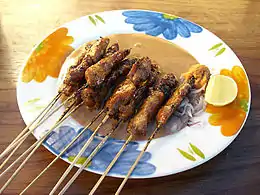 |
A Southeast Asian dish consisting of diced or sliced meat, skewered and grilled over a fire, then served with various spicy seasonings. It was developed by Javanese street vendors as a unique adaptation of Indian kebabs.[51][5] |
| Shashlik |  |
Shashlyk, meaning skewered meat, was originally made of lamb.[52] Nowadays it is also made of pork or beef depending on local preferences and religious observances. |
| Shish kebab |  |
A popular meal of skewered and grilled cubes of meat.[53] |
Notes
- "In Pakistan, animal tallow is used as commercial deep-frying agent for the traditional food chapli kebab. The chapli and shami kabab are considered as one of the most commercially available traditional dishes of people living in Pakistan, ..."[40]
References
- Ozlem Warren (May 11, 2015). "Eggplant kebab with yoghurt marinated chicken; Patlicanli Kebap". Ozlem's Turkish Table. Archived from the original on January 7, 2019. Retrieved February 24, 2016.
- Marks, Gil (2010-11-17). Encyclopedia of Jewish Food. ISBN 9780544186316. Archived from the original on 2020-12-13. Retrieved 17 February 2020.
- Dalal, Tarla (2007-06-15). Punjabi Khana. ISBN 9788189491543. Archived from the original on 2016-01-21. Retrieved 2 November 2014.
- Raichlen, S. (2015). Planet Barbecue!: 309 Recipes, 60 Countries (in German). Workman Publishing Company. p. 251. ISBN 978-0-7611-6447-0. Archived from the original on December 15, 2019. Retrieved May 26, 2017.
- Davidson, Alan (2006). The Oxford Companion to Food (2nd ed.). Oxford: OUP Oxford. ISBN 9780191018251. OCLC 862049879.
- Agence France-Presse (22 May 2012). "Nigerian roadside barbecue shacks thrive in the midst of Islamist insurgency". The Raw Story. Archived from the original on 7 April 2014. Retrieved 5 April 2014.
- Osseo-Asare, Fran (2005). Food culture in sub-Saharan Africa. Greenwood Press. p. 41. OCLC 58527114.
- Dako, Kari (2003). Ghanaianisms : a glossary. Accra: Ghana Universities Press. pp. 59, 201. ISBN 9789964303013. OCLC 53432897.
- Adjonyoh, Zoe (2017). Zoe's Ghana Kitchen. UK: Hachette. ISBN 9781784721985.
- "recipe". Archived from the original on 21 January 2016. Retrieved 2 November 2014.
- "Bihari kabab". ALL THINGS PAKISTAN. Archived from the original on 2 November 2014. Retrieved 2 November 2014.
- Singh, S. (2009). India. Ediz. Inglese. Country Guide Series (in Turkish). Lonely Planet. p. 262. ISBN 978-1-74220-347-8. Retrieved May 26, 2017.
- DK Eyewitness Travel Guide Delhi, Agra and Jaipur. EYEWITNESS TRAVEL GUIDES. DK Publishing. 2015. p. 246. ISBN 978-1-4654-4945-0. Archived from the original on December 14, 2019. Retrieved May 22, 2018.
- Raichlen, S.; Fink, B. (2008). The Barbecue! Bible. Workman Pub. p. 246. ISBN 978-0-7611-4944-6. Archived from the original on December 12, 2019. Retrieved May 22, 2018.
- "বঙ্গ-চৈনিক খাদ্য প্রীতি! রসনা তৃপ্তিতে চলে আসুন এই ঠিকিনায়". eisamay.indiatimes.com (in Bengali). 28 November 2018. Archived from the original on 28 November 2018. Retrieved 19 April 2020.
- "Streetfood - Adam's Kabab (Phears Lane, Chuna Gali, near Central Metro station, Kolkata)". 22 October 2012. Archived from the original on 12 August 2015. Retrieved 20 July 2015.
- "6 Unique Kebabs in India and Where To Find Them". mistay. Archived from the original on 2020-11-09. Retrieved 2020-11-09.
- Oseland, J.; Magazine, E.S. (2011). Saveur: The New Comfort Food: Home Cooking from Around the World. Chronicle Books LLC. p. 124. ISBN 978-1-4521-0539-0. Archived from the original on December 14, 2019. Retrieved May 26, 2017.
- DK Eyewitness Travel Guide: Cyprus. DK Publishing. 2010. p. 174. ISBN 978-0-7566-7405-2. Archived from the original on December 11, 2019. Retrieved May 26, 2017.
- Matalas, Antonia-Leda; Yannakoulia, Mary (2000). "Greek Street Food Vending: An Old Habit Turned New". In Simopoulos, Artemis P.; Bhat, Ramesh Venkataramana (eds.). Street Foods. Karger Medical and Scientific Publishers. p. 6. ISBN 978-3-8055-6927-9. Archived from the original on 2019-12-12. Retrieved 2017-09-26.
- Flores, E.K. (2016). Adventures in Chicken: 150 Amazing Recipes from the Creator of AdventuresInCooking.com. Houghton Mifflin Harcourt. p. 115. ISBN 978-0-544-55821-2. Archived from the original on November 15, 2019. Retrieved May 26, 2017.
- Singh, S. (2009). India. Ediz. Inglese. Country Guide Series (in Turkish). Lonely Planet. p. 262. ISBN 978-1-74220-347-8. Retrieved May 26, 2017.
- "Dora kabab". Khaleej Times. October 22, 2015. Archived from the original on September 27, 2017. Retrieved May 26, 2017.
- India Today. 26. Thomson Living Media India Limited. 2001. p. 163. Archived from the original on December 13, 2019. Retrieved May 26, 2017.
- Kraig, B.; Sen, C.T. (2013). Street Food Around the World: An Encyclopedia of Food and Culture. ABC-CLIO. p. 176. ISBN 978-1-59884-955-4. Archived from the original on December 15, 2019. Retrieved May 26, 2017.
- "8 meatilicious kebabs you must try out immediately". India Today. May 11, 2016. Archived from the original on May 25, 2017. Retrieved May 26, 2017.
- Banerji, C. (2008). Eating India: An Odyssey into the Food and Culture of the Land of Spices. Bloomsbury Publishing. p. 125. ISBN 978-1-59691-712-5. Archived from the original on December 12, 2019. Retrieved May 26, 2017.
- Chaturvedi, A.; Kanwar, D.; Sengupta, R. (2013). DK Eyewitness Travel Guide: Delhi, Agra and Jaipur. DK Publishing. p. 253. ISBN 978-1-4654-1492-2. Archived from the original on November 19, 2019. Retrieved May 26, 2017.
- Kalra, J.I.S.; Das Gupta, P. (1986). Prashad: Cooking with Indian Masters. First Edition. Allied Publishers Private Limited. p. 20. ISBN 978-81-7023-006-9. Archived from the original on December 12, 2019. Retrieved May 26, 2017.
- Kapoor, S.; Kapoor, A. (2009). Marwari Vegetarian Cooking (in German). Popular Prakashan. p. 25. ISBN 978-81-7991-399-4. Archived from the original on December 14, 2019. Retrieved May 26, 2017.
- World, E.Y.; Siciliano-Rosen, L.; Rosen, S. (2014). Delhi Food and Travel Guide: The inside scoop on the best North Indian foods in Delhi. 107. Eat Your World. p. pt51. Archived from the original on December 11, 2019. Retrieved May 26, 2017.
- DK Eyewitness Travel Guide: Delhi, Agra & Jaipur. DK Publishing. 2015. p. 248. ISBN 978-1-4654-4945-0. Archived from the original on December 11, 2019. Retrieved May 26, 2017.
- DK Eyewitness Travel Guide: Delhi, Agra & Jaipur. DK Publishing. 2015. p. 246. ISBN 978-1-4654-4945-0. Archived from the original on December 14, 2019. Retrieved May 26, 2017.
- "Reshmi Kebab (Silken Kebabs)". Allrecipes.com. Archived from the original on 14 September 2014. Retrieved 2 November 2014.
- Yelda, Rami (2012). A Persian Odyssey: Iran Revisited. AuthorHouse. ISBN 9781477202913. Archived from the original on 2020-12-13. Retrieved 2020-10-02.
- "Archived copy". Archived from the original on 2020-12-13. Retrieved 2020-12-13.CS1 maint: archived copy as title (link)
- "Kuwait News Agency (KUNA)". Archived from the original on 22 September 2013. Retrieved 2 November 2014.
- The Cooking of the Middle East, Time-Life Books (1969)
- Raichlen, S.; Fink, B. (2008). The Barbecue! Bible. Workman Pub. p. 226. ISBN 978-0-7611-4943-9. Archived from the original on December 12, 2019. Retrieved May 26, 2017.
- Pakistan, Chemical Society of (2008). Journal of the Chemical Society of Pakistan. 30. Chemical Society of Pakistan. p. 750. Archived from the original on December 13, 2019. Retrieved May 26, 2017.
- Raichlen, S.; Fink, B. (2008). The Barbecue! Bible. Workman Pub. p. 163. ISBN 978-0-7611-4944-6. Archived from the original on December 16, 2019. Retrieved May 26, 2017.
- Marks, Gil (2010). Encyclopedia of Jewish Food. Houghton Mifflin Harcourt. ISBN 978-0-544-18631-6. Archived from the original on 2019-01-07. Retrieved 2018-03-22.
- Turkish Cookery by M.Günür ISBN 975-479-100-7
- Roden, Claudia (2008). The New Book of Middle Eastern food. New York: Alfred A. Knopf. p. 241. ISBN 9780307558565. OCLC 430828581. Archived from the original on 2020-12-13. Retrieved 2020-10-02.
- Tatlıdan, tuzluya Türk sofrası: alaturka - alafranga; yemekler ve tatlılar. Geçit Kitabevi. 1982. Archived from the original on 2016-01-21. Retrieved 2016-01-10.
- "Three Renowned Turkish Restaurants: Beyti Meat Restaurant". Skylife - Turkish Airlines Magazine (12): 1–4. 2000. Archived from the original on 2012-02-09. Retrieved 2013-11-09.
- Banu Atabay. Mütevazi Lezzetler Deutsch. Banu Atabay. pp. 98–. GGKEY:QQKUPZ6WZ7J. Archived from the original on 2016-01-21. Retrieved 2016-01-10.
- The Complete Book of Turkish Cooking, A.Algar (1985) ISBN 0-7103-0334-3
- Metin Sözen (2005). Taşın belleği Mardin. Yapı Kredi Kültür Sanat Yayıncıkık. ISBN 978-975-08-1029-9. Archived from the original on 2016-01-21. Retrieved 2016-01-10.
- "Prepared Foods". Vol. 157 no. 11–13. Gorman Publishing Company. 1988. p. 92. Archived from the original on December 15, 2019. Retrieved June 13, 2018. Cite magazine requires
|magazine=(help) - Bruce Kraig; Colleen Taylor Sen (2013). Street Food Around the World: An Encyclopedia of Food and Culture. ABC-CLIO. p. 183. ISBN 9781598849554. Archived from the original on 2020-12-13. Retrieved 2020-10-02.
- Aidells, B.; Kelly, D. (2001). The Complete Meat Cookbook: A Juicy and Authoritative Guide to Selecting, Seasoning, and Cooking Today's Beef, Pork, Lamb, and Veal. Houghton Mifflin Harcourt. p. 466. ISBN 978-0-547-34760-8. Archived from the original on December 11, 2019. Retrieved June 13, 2018.
- John Ayto (18 October 2012). The Diner's Dictionary: Word Origins of Food and Drink. OUP Oxford. pp. 192–. ISBN 978-0-19-964024-9.
External links
| Wikimedia Commons has media related to Kebabs. |
| Look up kebab in Wiktionary, the free dictionary. |
- 50 Kebabs. Food Network Magazine.
